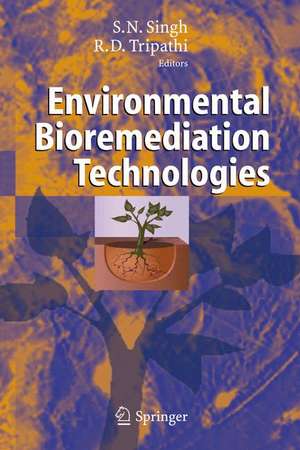Environmental Bioremediation Technologies
Editat de S.N. Singh, R. D. Tripathien Limba Engleză Hardback – 30 oct 2006
| Toate formatele și edițiile | Preț | Express |
|---|---|---|
| Paperback (1) | 1056.04 lei 38-44 zile | |
| Springer Berlin, Heidelberg – 14 oct 2010 | 1056.04 lei 38-44 zile | |
| Hardback (1) | 1238.23 lei 43-57 zile | |
| Springer Berlin, Heidelberg – 30 oct 2006 | 1238.23 lei 43-57 zile |
Preț: 1238.23 lei
Preț vechi: 1510.05 lei
-18% Nou
Puncte Express: 1857
Preț estimativ în valută:
236.94€ • 248.01$ • 197.21£
236.94€ • 248.01$ • 197.21£
Carte tipărită la comandă
Livrare economică 31 martie-14 aprilie
Preluare comenzi: 021 569.72.76
Specificații
ISBN-13: 9783540347903
ISBN-10: 3540347909
Pagini: 540
Ilustrații: XX, 520 p. 58 illus.
Dimensiuni: 155 x 235 x 37 mm
Greutate: 1.03 kg
Ediția:2007
Editura: Springer Berlin, Heidelberg
Colecția Springer
Locul publicării:Berlin, Heidelberg, Germany
ISBN-10: 3540347909
Pagini: 540
Ilustrații: XX, 520 p. 58 illus.
Dimensiuni: 155 x 235 x 37 mm
Greutate: 1.03 kg
Ediția:2007
Editura: Springer Berlin, Heidelberg
Colecția Springer
Locul publicării:Berlin, Heidelberg, Germany
Public țintă
ResearchCuprins
Bioremediation of Organic and Metal Co-contaminated Environments: Effects of Metal Toxicity, Speciation, and Bioavailability on Biodegradation.- New Bioremediation Technologies to Remove Heavy Metals and Radionuclides using Fe(III)-, Sulfate- and Sulfur- Reducing Bacteria.- Bioremediation of Soils Polluted with Hexavalent Chromium using Bacteria: A Challenge.- Accumulation and Detoxification of Metals by Plants and Microbes.- Role of Phytochelatins in Phytoremediation of Heavy Metals.- Metal Resistance in Plants with Particular Reference to Aluminium.- Bioremediation of Metals: Microbial Processes and Techniques.- Phytoremediation of Metals and Radionuclides.- Nanotechnology for Bioremediation of Heavy Metals.- Biotechnological Approaches to Improve Phytoremediation Efficiency for Environment Contaminants.- Aquatic Plants for Phytotechnology.- Phytomonitoring of Air Pollutants for Environmental Quality Management.- Phytoremediation of Air Pollutants: A Review.- Phytoremediation: Role of Plants in Contaminated Site Management.- The Role of Macrophytes in Nutrient Removal using Constructed Wetlands.- Nitrate Pollution and its Remediation.- Bioremediation of Petroleum Sludge using Bacterial Consortium with Biosurfactant.- Diversity, Biodegradation and Bioremediation of Polycyclic Aromatic Hydrocarbons.- Environmental Applications of Fungal and Plant Systems: Decolourisation of Textile Wastewater and Related Dyestuffs.- Fungal-Based Remediation: Treatment of PCP Contaminated Soil in New Zealand.- Biofilms in Porous Media: Mathematical Modeling and Numerical Simulation.
Caracteristici
This book deals with the integrated approach of bioremediaton to decontaminate the sites & effluents and to mitigate air pollution.




